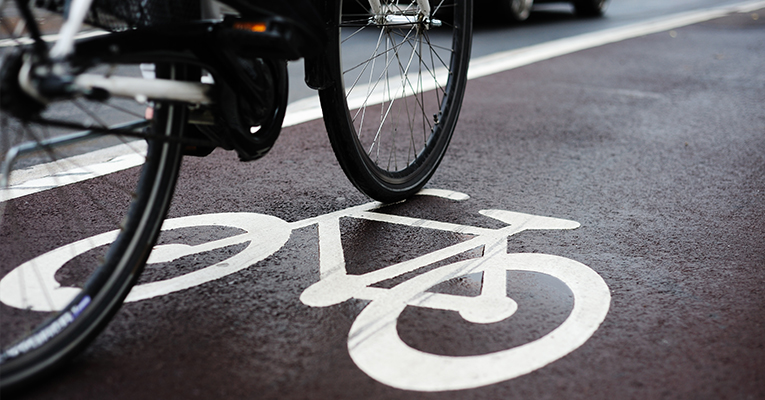rethink sustainability
How will the planet keep moving in a post-COVID world?


Many cities have experienced dramatically cleaner air because of a sharp drop in global transport after the seismic changes brought on by the crisis. But is this transport shift here to stay, or will companies and consumers return to their previous habits as soon as travel restrictions are lifted?
At Lombard Odier we embrace the clearer skies and the 5.4% drop in CO2 emissions in 2020, the largest decline on record. We expect some behaviour to normalise once global travel and trade disruptions ease but we believe many new and cleaner modes of transport may emerge as companies focus on supply chain risk mitigation and embrace the cost effectiveness of greener mobility options.
We also expect policymakers to learn from the cleaner streets and embrace new regulatory approaches to both long and short-haul transportation. Consumers may find that new travel habits stick - the 'flygskam' or flight shaming movement may intensify with more questions raised about the necessity of trips. We expect this behavioural shift in mobility to present multiple investment opportunities, as well as systemic risks for some industries.
As travel drops, the traffic clears
Transport currently accounts for 14% of all global CO2 emissions. Of those, 74% are road transport, 12% aviation and 11% shipping.
The COVID-19 crisis has seen a dramatic drop in all transportation as countries have imposed restrictions to public movement. In many cities, for the first time in years, roads were traffic-free and air pollution felt more than 50%.
The TomTom traffic index showed that in 2019 the average person spent an extra 87 minutes in traffic than in the previous year. But in 2020, cities with travel restrictions have seen congestion drop by up to 85%. Pre-COVID, the average personal car sat idle in parking spaces for 96% of the time. We believe our transport system was WILD - Wasteful, Idle, Lopsided and Dirty - and urgently needed to transition to being CLIC - Circular, Lean, Inclusive and Clean. Regulators started to push this process with fleet average CO2 emissions, low emission zones, parking restrictions and electric vehicle incentives. However, the speed of delivery has been slower than that needed to comply with net-zero pledges. One of the few positives that could come out of the current public health tragedy could be a faster transition to “CLIC" mobility.
No matter the problems, personal travel is car-centric
International governments, regulating some 85% of the global light-vehicle market, have committed to or are proposing a ban on internal combustion engine (ICE) vehicles within the next 20 years. In China, the state council has decreed that megacity air quality represents not just a threat to public health – it is now estimated that air pollution kills more people globally every year than smoking - but also to civil order. There are low-emissions zones and bans on older cars in multiple cities globally as a result of worsening urban air quality. The issue of nitrous oxide (NOx) was brought to public attention even more directly by 2015's “Dieselgate".
But despite higher cost and pollution effects, the convenience of the personal car makes it the predominant mode of transport in most developed markets:
Many local governments were initiating ICE restrictions in city centres long before the current crisis. Oslo has closed off certain streets to cars and removed almost all parking spaces, replacing them with cycle lanes and green spaces. Mexico has initiated the 'pico y placa' initiative, where the right to drive depends on your licence plate and Singapore has punitively high taxation on the car to discourage use. In Paris, there are plans to remove 60,000 car parking spaces, or 72% of the total. The Paris mayor announced in January that she wants all Parisian streets to be cycle-friendly by 2024, with plans for a “city of fifteen minutes".
And yet pre-COVID, global traffic data shows congestion is growing dramatically each year, worsened by the popularity of online deliveries and ride-hailing. Average road speeds in many city centres were as low as 5 to 6mph, which helped to hasten the advent of micromobility on small, shared electric two and three-wheel vehicles. Electric scooters and bikes can reach much higher average speeds in congested urban areas.
Could we see a shift post-lockdown?
The impact of lockdown on city streets has been traffic-free roads, greater space and safety for pedestrians and cyclists and clearer air. But will cities just return to normal once travel restrictions are eased? In Wuhan, public transport was shut down entirely during the lockdown, with key workers only able to use the popular shared bike schemes to travel to work. Other cities have shut down micromobility schemes and kept public transport operating. Many cities have had to contend with severely reduced demand for public transport and it is unclear how quickly this demand will recover, with many commuters likely to distrust the health implications of crowded, public transport. In Paris, plans to ease lockdown in the city involve increasing cycle lanes to take the pressure off public transport. Similar measures are being discussed in London to ban cars from certain roads, lower speed limits and widen pavements to enable safer foot and cycle trips.
An increase in foot and bike traffic would be a bonus for air pollution but there is a risk that an ongoing shift away from public transport could also lead to a surge in personal car usage when lockdowns lift. In terms of CO2 emissions, and congestion and air pollution, this would be a worst-case scenario. After walking, cycling and micromobility, public transport has a much better environmental footprint than a single-occupancy or even dual-occupancy car.
Many public transport systems are in need of support due to a sharp fall in demand. The US Department of Transport has already offered $1bn to the National Railroad Passenger Corporation to support the railroad's activities. We certainly expect to see a shift in how public transport systems are utilised in the coming months. Many private companies are preparing for these changes by offering greater access to travel statistics to enable consumers and policymakers to make better mobility decisions and manage shifting demand. Technology will enable greater understanding of transport patterns - for instance Apple has made mobility data available to aid COVID-19 decision making. More connected transport apps will also offer commuters greater choice over transport mode, particularly for first and last-mile journeys. This is likely to drive a greater uptake of MaaS (mobility as a service) as more commuters prefer flexibility of transport mode and the ability to share journeys via micro-transit rather than public transit. Many businesses are also shifting their business models entirely with Honda converting vehicles to transport patients, US ride-hail operator Lyft helping with the delivery of essential items and London-based taxi service Addison Lee partnering with coach platform Zeelo to provide transport and logistics to support healthcare
Could the dominance of the road in city centres be coming to an end? Does it really make sense that 70% of short journeys (less than five miles) are taken by car? We believe that given the likely staggered approach to lifting transport restrictions, combined with an increased trust in tele-working, daily commutes could remain reduced for months to come. Many city policymakers could take this time as an opportunity to impose even greater restrictions on car usage. If more cities adopt the “city of fifteen minutes" approach, we could see a gradual reduction in cross-city commutes. But cost will play a significant role in transport mode.
How the impact of COVID-19 could weigh on transport usage
One of tragedies of the current crisis is the enormity of the ensuing impact on the global economy and the consumer. With many millions of jobs at risk, pressure will grow on monthly spending patterns. While short-term mistrust of public transport may force some commuters to personal cars, for many the cost will prove prohibitive. While the variable cost of an owned vehicle is only US$ 0.18/mile (falling as oil prices remain depressed), fixed costs such as urban parking, taxation, depreciation and insurance drive the average cost/mile to $0.98 ($0.73 ex-parking) for the average car or $0.73 for a used car or electric vehicle.
This cost varies depending on mileage. The figures above are based on an average mileage of 11,000 miles/year. But a car used for just a two-mile/day commute (730 miles/year) would cost $11/mile. The same trip by public transport or micromobility would cost c$2/mile or by ridehail c$6/mile in the US. But on foot the trip would be free. In the US, according to national statistics, 57% of households own two or more cars. This compares to 20-40% owning multiple cars in Europe. Many of these cars drive very low mileages and might easily be foregone in favour of cheaper modes of transport, were household incomes to decline sharply. If policymakers decide to put further pressure on car travel via cost/mile road taxation, some households might decide to jettison the car entirely. Around 20% of European households do not own a car at all (9% of US households) but these figures could rise. In emerging markets where car penetration is much lower, households could leapfrog car ownership entirely and shift to MaaS.
While this piece has focused on short-haul road transport, it is also clear that there could be significant shifts to long-haul transport post-COVID-19. The flight-shaming movement which emerged in Sweden and saw air traffic fall by 8% in January 2020 may return with a vengeance as more consumers focus on responsible tourism. Leisure travel by air may not recover as sharply post-COVID as many anticipate and business travel may also be severely curtailed as corporates discover the convenience and cost-effectiveness of virtual conferencing.
The IATA may be asking for a near-term relaxation of proposed CO2 regulation on the aviation industry, as a result of the sharp drop in demand during the crisis, but net-zero targets are enshrined in law for many countries and will require a concerted effort to reduce emissions from long-haul transport as much as from short-haul. Shipping and freight transport will also remain in the spotlight, due to the carbon-intensity of current methods. Corporates may permanently shift their supply chains closer to home because of the supply chain risk highlighted by COVID-19. This could have the unintended consequence of reducing travel demand and helping to cut transport emissions.
A lasting effect
We see the devastating effects of the current crisis as having long-term implications for travel. Business-as-usual may return in some areas in the coming months but we suspect a shift in many modes of transport will linger. This could provide a much-needed opportunity to reduce emissions from transport, which is one of the only sectors in the EU and the US where emissions continue to rise. It will require concerted action from policymakers, corporates and consumers to enforce the change. At Lombard Odier we see significant investment opportunities as a result of this Transport Revolution to a Circular, Leaner, more Inclusive and Cleaner (CLIC) mobility model. We see opportunities across Technology, MaaS and emerging, cleaner transport modes such as micromobility. We also see risks for some incumbent business models such as car ownership, combustion engines, air travel and oil demand.
Wichtige Hinweise.
Die vorliegende Marketingmitteilung wurde von der Bank Lombard Odier & Co AG oder einer Geschäftseinheit der Gruppe (nachstehend “Lombard Odier”) herausgegeben. Sie ist weder für die Abgabe, Veröffentlichung oder Verwendung in Rechtsordnungen bestimmt, in denen eine solche Abgabe, Veröffentlichung oder Verwendung rechtswidrig wäre, noch richtet sie sich an Personen oder Rechtsstrukturen, an die eine entsprechende Abgabe rechtswidrig wäre.
Entdecken Sie mehr.







teilen.